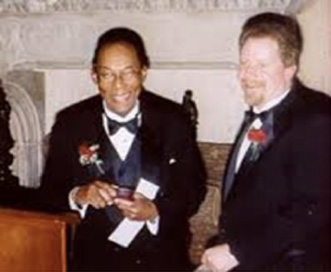Forgotten Histories of Black Engineers and Scientists
Black engineers and scientists are often forgotten, misrepresented, or misappropriated for their inventions and achievements.

This Black History Month, we present five biographies of Black engineers and scientists who made significant contributions to knowledge and to bettering our lives. From Rockcliffe Manley, who first electrospun a polymer – to Alice H Parker’s development of a central heating system – we all benefit from their brilliant and thoughtful inventions.
These biographies were put together as part of an EPSRC funded Equity, Diversity, and Inclusion (ED&I) fellowship by Dr Anita Etale (pictured above left), Dr Amaka Onyianta (pictured above right), Professor Steve Eichhorn and Pankhuri Agarwal. We would love to hear from you if you have any thoughts or reflections. We’d also like to know from you about other Black scientists and engineers and their inventions. For more information about this work and any ongoing activities to address ED&I with respect to Black and Black heritage staff and students, please contact the team.
- Meredith Gourdine: Pioneer Researcher and Inventor in Electrogas Dynamics (Engineer)
Gourdine was born in Newark, New Jersey, on September 26, 1929. In addition to winning a silver medal in the long jump at the Helsinki Olympic games in 1952, Gourdine obtained a bachelor’s degree in engineering from Cornell University in 1953 and a PhD in engineering physics from the California Institute of Technology in 1960 on a Guggenheim fellowship. He joined Plasmadyne Corporation the same year as director of the aerospace laboratory. Two years later he joined Curtis Wright Corporation as chief scientist in charge of a project to develop spaceship engines. He started his own company, Gourdine Systems, Inc, becoming a full-time inventor in 1964. Gourdine remains one of the most respected scientists in electrodynamics, receiving 27 patents in the field. He is best known for the invention of electrostatic precipitator systems, particularly Incineraid (patented in 1972), which helps remove smoke from burning buildings, and a method of airport fog precipitation (patented in 1987). Other patents include applications of electrogas dynamics to circuit breakers, acoustic imaging, air monitors, coating systems, and the Focus Flow Heat Sink, which is used to cool computer chips.
- Lloyd Augustus Hall: Pioneer of Food Preservation (Chemist)

Hall investigated the use of spices such as ginger in food preservation Lloyd Augustus Hall was born on 20 June 1894 in Illinois. He received a Bachelor of Science degree from Northwestern University in 1916. Hall devoted much effort to improving the curing salts used for flash-drying of meat. The procedure for producing the salts originated with Karl Max Siefart who patented the production process in 1934. Hall took a leading role in improving the process once the patent was bought by his employer, Griffith Laboratories. A major challenge with the salts was their tendency for caking, and Hall designed ways to reduce this using hygroscopic agents e.g., glycerin and corn sugar.
Hall also investigated the use of spices in food preservation. Spices including cloves and ginger were often used as antimicrobial agents in food preservation, but Hall showed that these carried many bacteria, yeast, and spores and actually contributed to spoilage. He devised the “Ethylene Oxide Vacugas treatment” to control the growth of mold and bacteria in the spices while maintaining their appearance, taste, and aroma. His sterilization methods are still used in medicine and cosmetics today. Hall held 105 patents covering areas such as solid seasonings, flavouring compounds, and protective food coatings.
He was awarded honorary doctorates from Virginia State University, Howard University, and the Tuskegee Institute. Hall was the first African American elected to the National Board of Directors of the American Institute of Chemists. In 2004 Hall was posthumously inducted into the Inventors’ Hall of Fame in honour of his pioneering contributions to the field of food preservation and science.
- Marie Van Brittan Brown: Inventor of a Home Security System (Nurse)

Brown’s innovation forms the basis for modern-day home surveillance systems. Image credit: Smart Home Perfected Marie Van Brittan Brown was an African American nurse who lived in Queens, New York with her electrician husband and two children. Concerned by the level of crime in her neighborhood, and the slow rate of response of police officers to emergency calls, Marie and her husband invented the home security surveillance system in 1966.
The closed-circuit television they invented has four peepholes and a camera that can capture video images at different heights and angles through the peepholes. The video images are then wirelessly transmitted to a monitor, which can be viewed at a different location in the home. The equipment also allows for audio communication between the occupant of the home and visitor on the doorstep through a microphone installed at both ends. The occupant can choose to open the door when the visitor is wanted or alarm security agency with the press of a button. Marie Van Brittan Brown and her husband applied for a patent on 1st August 1966, this was granted on 2nd December 1969.
Brown’s innovation forms the basis for surveillance systems and smart doorbells used today in homes and small businesses worldwide. Marie was born on October 30, 1922, and died on February 2, 1999.
- Alice H. Parker: Inventor of the Central Heating System (Engineer)
On 23 December 1919, Alice H. Parker was granted her patent for her invention of the central heating system that was powered by natural gas. This was 9 years after she graduated from Howard University, which was a great achievement for an African American woman in the 20th century.Parker’s invention was inspired by the inefficiency of heating up different parts of the home with wood/coal. Her gas furnace design offered greater operational flexibility because it can be controlled individually. The heating is supplied from hot air ducts that lead to different parts of the building. Parker’s exact design was not implemented but led to the thermostat and forced air heating used in many buildings today.
In recognition for her work, the New Jersey Chamber of Commerce named its “Women Leaders in Innovation” award after Alice H. Parker.
Not much is documented about Parker’s personal life, but it is widely reported that she was born in 1895 in Morristown, New Jersey, USA. Her year of death is also uncertain.
- Dr Rockcliffe St. J. Manley: Pioneer of Electrospinning and Cellulose Structure (Chemist)

Dr. Rockcliffe St. J. Manley receiving the Anselme Payen award from the Cellulose and Renewable Materials Division in 2002. (Source, Cellulose and Renewable Materials Division archive, American Chemical Society) Dr Rockcliffe St. J. Manley was born in Kingston, Jamaica, on 26th March 1925. He spent most of his academic career at McGill University in Canada, in the Pulp and Paper Science Division of the Chemistry Department. His parents were Harvey Arnold Manley and Vinette Madaline Bingham, and he had three brothers and one sister. He received his PhD from McGill University in 1953 on the subject “Rotations, Collisions and Orientations in Model Suspensions” (supervised by Stan Mason) and published early papers on the physics of particle motions.
Manley made substantial contributions to cellulose research and was the first person to electrospin a polymer. He did not receive recognition for this discovery, with others getting credit for solution electrospinning of polymers, which was a later development. Manley spun molten polymers and showed that they (if thin enough) had a shish-kebab structure. His PhD student, Lidia Larrondo, with whom he published the electrospinning work, was a refugee from Pinochet’s Chile.
He developed a chain folding theory for the structure of cellulose, which was heavily criticised at the time. He based his work on that of Andrew Keller, who was at the University of Bristol. Keller had produced a structure for polyethylene that required the polymer chains to fold, in what is now known as lamellae, making up a spherulitic structure.
Manley applied the same theories to cellulose. It is only in recent times that his work is being revisited. While we do not believe that the cellulose structure is fully chain-folded, it is energetically favourable to see chain folds. So, there may be some validity to the theory after all! Manley carried out high-resolution electron microscopy for his work on this chain folded structure, which was no mean feat back in 1964 since the very first prototype electron microscope had only been delivered to the Pulp and Paper Research Institute, where Manley worked, in 1958.
Manley won the Anselme Payen Award from the Cellulose and Renewable Materials Division in 2002.
Rockcliffe St. J. Manley died in 2011. Not much is known about his life, and only a small obituary can be found at Rockliffe MANLEY Obituary (2012) – Montreal, Quebec – The Gazette (legacy.com).

